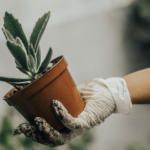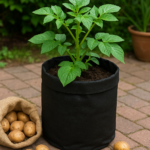The Boston Fern (Nephrolepis exaltata), also known as the sword fern, is one of the most popular houseplants worldwide. Renowned for its lush, feathery fronds and air-purifying qualities, this fern has become a staple in homes, offices, and gardens. Native to tropical and subtropical regions, the Boston Fern is relatively easy to care for, making it a favorite among both novice and experienced plant enthusiasts. In this article, we’ll explore everything you need to know about the Boston Fern, from its origins and characteristics to its care requirements and benefits.
Origins and History of the Boston Fern

The Boston Fern is native to regions such as Florida, the West Indies, Central and South America, and Africa. It thrives in humid, shaded environments, often found growing on forest floors or along riverbanks. The plant was first discovered in the late 19th century and quickly gained popularity as a houseplant due to its elegant appearance and adaptability.
The name “Boston Fern” originated from its widespread cultivation in Boston, Massachusetts, during the Victorian era. It became a symbol of refinement and was commonly used in parlors and conservatories. Over time, the Boston Fern has been hybridized to produce various cultivars, each with unique characteristics.
Today, the Boston Fern is celebrated not only for its aesthetic appeal but also for its ability to improve indoor air quality. Its rich history and enduring popularity make it a timeless choice for plant lovers.
Characteristics
The Boston Fern is characterized by its long, arching fronds that can grow up to 3 feet in length. Each frond is composed of numerous small, delicate leaflets, giving the plant a feathery, lush appearance. The vibrant green color of the foliage adds a touch of nature to any space.
One of the most distinctive features of the Boston Fern is its ability to produce spores rather than seeds. These spores are found on the undersides of the fronds and are responsible for reproduction. While the plant does not flower, its graceful foliage more than compensates for the lack of blooms.
Boston Ferns are also known for their air-purifying qualities. They are effective at removing toxins such as formaldehyde and xylene from the air, making them a healthy addition to indoor environments. Additionally, their dense foliage provides a natural humidifying effect, which can be beneficial in dry climates.
Popular Varieties of Boston Ferns
There are several cultivars of Boston Ferns, each with unique characteristics. Some popular varieties include:
‘Bostoniensis’
The classic Boston Fern, known for its long, arching fronds and dense foliage.
‘Fluffy Ruffles’
A compact variety with finely textured, ruffled fronds.
‘Golden Boston’
This variety features golden-green fronds, adding a unique color contrast to your plant collection.
‘Dallas’
A dwarf variety that is ideal for small spaces or tabletop displays.
Ideal Growing Conditions for Boston Ferns

To thrive, Boston Ferns require specific growing conditions that mimic their natural habitat. Here are the key factors to consider:
Light Requirements
Boston Ferns prefer bright, indirect light. Direct sunlight can scorch their delicate fronds, while too little light can lead to sparse growth. A north or east-facing window is ideal for providing the right amount of light.
Temperature and Humidity
These ferns thrive in temperatures between 60°F and 75°F (15°C to 24°C). They are sensitive to cold drafts and sudden temperature changes, so it’s important to keep them away from air conditioning vents or heaters. High humidity is essential for Boston Ferns, as low humidity can cause the fronds to turn brown and dry out.
Soil and Watering
Boston Ferns prefer well-draining, slightly acidic soil. A mix of peat moss, perlite, and potting soil works well. The soil should be kept consistently moist but not waterlogged. Overwatering can lead to root rot, while underwatering can cause the fronds to wilt.
Fertilization
Boston Ferns benefit from regular fertilization during the growing season (spring and summer). A balanced, water-soluble fertilizer can be applied every 4-6 weeks to promote healthy growth.
Common Problems and Solutions
Despite their resilience, Boston Ferns can encounter a few issues. Here are some common problems and how to address them:
Brown or Yellowing Fronds
This is often caused by low humidity, overwatering, or insufficient light. Increase humidity by misting the plant regularly or using a humidifier. Adjust watering practices and ensure the plant receives adequate indirect light.
Pests
Boston Ferns are susceptible to pests such as spider mites, mealybugs, and scale. Regularly inspect the plant for signs of infestation and treat it with insecticidal soap or neem oil if necessary.
Root Rot
Overwatering can lead to root rot, which is characterized by black, mushy roots. To prevent this, ensure the soil drains well and avoid letting the plant sit in water.
Wilting
Wilting can be a sign of underwatering or low humidity. Increase watering frequency and consider placing the plant on a pebble tray filled with water to boost humidity.
Benefits of Growing Boston Ferns
Boston Ferns offer numerous benefits, making them a worthwhile addition to any space:
Air Purification
As mentioned earlier, Boston Ferns are excellent at removing toxins from the air, contributing to a healthier indoor environment.
Aesthetic Appeal
Their lush, green foliage adds a touch of elegance and tranquility to any room. They are often used in hanging baskets or as floor plants to create a natural, calming atmosphere.
Humidifying Effect
Boston Ferns release moisture into the air, which can help alleviate dry skin and respiratory issues, especially during winter months.
Stress Reduction
Studies have shown that indoor plants, including Boston Ferns, can reduce stress and improve overall well-being. Their presence can create a sense of connection to nature, even in urban settings.
Propagation of Boston Ferns

Propagating Boston Ferns is relatively simple and can be done through division or spores. Here’s how:
Division
- Remove the plant from its pot and gently separate the root ball into smaller sections.
- Ensure each section has healthy roots and fronds.
- Plant the divisions in fresh potting mix and water thoroughly.
Spores
- Collect spores from the undersides of mature fronds.
- Sprinkle the spores onto a tray filled with moist peat moss.
- Cover the tray with plastic to retain humidity and place it in a warm, shaded area.
- Once the spores germinate and develop into small plants, transplant them into individual pots.
Decorating with Boston Ferns
Boston Ferns are versatile and can be used in various ways to enhance your home or office decor:
- Hanging Baskets: Their cascading fronds make them perfect for hanging baskets, adding a touch of greenery to any room.
- Floor Plants: Larger Boston Ferns can be placed in decorative pots and used as floor plants to create a focal point.
- Terrariums: Smaller varieties can be incorporated into terrariums for a miniature indoor garden.
- Outdoor Spaces: In mild climates, Boston Ferns can be grown outdoors in shaded areas, such as patios or balconies.
Seasonal Care for Boston Ferns
Boston Ferns require slightly different care depending on the season. Understanding their seasonal needs will help you keep your fern healthy and vibrant year-round. Here’s a breakdown of how to care for your Boston Fern in each season:
Spring Care
Spring is the start of the growing season for Boston Ferns, making it a critical time for care.
Key Tasks:
- Increase Watering: As temperatures rise, the fern’s water needs will increase. Keep the soil consistently moist but not waterlogged.
- Fertilize: Begin fertilizing with a balanced, water-soluble fertilizer every 4-6 weeks to support new growth.
- Prune: Trim away any dead or damaged fronds from the winter to encourage fresh growth.
- Repot if Needed: If the fern has outgrown its pot, spring is the ideal time to repot it into a larger container with fresh soil.
- Increase Humidity: As the air becomes drier, mist the plant regularly or use a humidifier to maintain high humidity levels.
Summer Care
Summer is the peak growing season for Boston Ferns, but it also brings challenges like heat and dry air.
Key Tasks:
- Water Frequently: Check the soil daily and water when the top inch feels dry. Ferns may need watering every 2-3 days in hot weather.
- Provide Shade: If grown outdoors, ensure the fern is in a shaded area to protect it from direct sunlight, which can scorch the fronds.
- Maintain Humidity: Continue misting the plant or using a pebble tray to combat dry summer air.
- Fertilize Regularly: Continue fertilizing every 4-6 weeks to support vigorous growth.
- Watch for Pests: Inspect the plant regularly for pests like spider mites, which are more active in warm weather.
Fall Care
As temperatures cool in fall, Boston Ferns begin to slow their growth and prepare for dormancy.
Key Tasks:
- Reduce Watering: As growth slows, the fern’s water needs will decrease. Allow the top inch of soil to dry out slightly between waterings.
- Stop Fertilizing: Discontinue fertilization in late fall to allow the plant to enter its dormant phase.
- Bring Indoors: If your fern is outdoors, bring it inside before the first frost. Choose a location with bright, indirect light and stable temperatures.
- Prune Lightly: Remove any yellowing or dead fronds to keep the plant tidy.
- Monitor Humidity: Indoor heating can dry out the air, so continue misting or using a humidifier.
Winter Care
Winter is the most challenging season for Boston Ferns due to low humidity and cooler temperatures.
Key Tasks:
- Water Sparingly: Overwatering is a common issue in winter. Water only when the top inch of soil is dry, typically once a week.
- Avoid Cold Drafts: Keep the fern away from windows, doors, and vents where cold drafts can damage the plant.
- Increase Humidity: Indoor heating can cause the air to become extremely dry. Use a humidifier or place the plant on a pebble tray to maintain humidity.
- Provide Adequate Light: Ensure the fern receives bright, indirect light, as shorter days can reduce natural light levels.
- Inspect for Pests: Check the plant regularly for pests, which can thrive in dry indoor conditions.
General Tips for Year-Round Care
- Rotate the Plant: Rotate the pot every few weeks to ensure even growth and light exposure.
- Clean the Fronds: Wipe the fronds gently with a damp cloth to remove dust and improve photosynthesis.
- Monitor for Stress: Watch for signs of stress, such as browning or wilting, and adjust care as needed.
How to Revive a Dying Boston Fern
1. Assess the Problem
Before taking action, identify the cause of the fern’s decline. Common issues include:
- Underwatering: Dry soil, wilting, and brown fronds.
- Overwatering: Yellowing fronds, soggy soil, and root rot.
- Low Humidity: Brown, crispy fronds.
- Insufficient Light: Sparse growth and pale fronds.
- Pests: Visible insects or webbing on the plant.
2. Trim Dead or Damaged Fronds
- Use clean, sharp scissors or pruning shears to remove dead, brown, or yellowing fronds.
- Cut the fronds at the base, close to the soil.
- This encourages new growth and improves the plant’s appearance.
3. Adjust Watering Practices
If Underwatered:
- Water the fern thoroughly until water drains out of the pot’s bottom.
- Ensure the soil remains consistently moist but not waterlogged.
- Check the soil daily and water when the top inch feels dry.
If Overwatered:
- Stop watering immediately and allow the soil to dry out slightly.
- Remove the plant from its pot and inspect the roots for rot (black, mushy roots).
- Trim away any rotten roots and repot the fern in fresh, well-draining soil.
4. Increase Humidity
Boston Ferns thrive in high humidity. To revive a dry fern:
- Mist the Fronds: Use a spray bottle to mist the plant daily.
- Use a Pebble Tray: Place the pot on a tray filled with water and pebbles. Ensure the pot is not sitting directly in the water.
- Group Plants Together: Place the fern near other plants to create a humid microclimate.
- Use a Humidifier: Place a humidifier near the plant to maintain consistent humidity.
5. Provide Proper Lighting
- Move the fern to a location with bright, indirect light. Avoid direct sunlight, which can scorch the fronds.
- If natural light is insufficient, consider using a grow light to supplement.
6. Check for Pests
- Inspect the fronds and soil for pests like spider mites, mealybugs, or scale.
- If pests are present:
- Wipe the fronds with a damp cloth to remove insects.
- Treat the plant with insecticidal soap or neem oil.
- Isolate the fern to prevent pests from spreading to other plants.
7. Repot if Necessary
- If the fern is root-bound (roots growing out of the drainage holes), repot it into a larger container.
- Use a well-draining potting mix, such as a blend of peat moss, perlite, and potting soil.
- Gently loosen the roots before placing the plant in the new pot.
8. Fertilize Sparingly
- Once the fern shows signs of recovery, apply a balanced, water-soluble fertilizer diluted to half strength.
- Fertilize every 4-6 weeks during the growing season (spring and summer).
- Avoid over-fertilizing, as this can damage the roots.
9. Maintain Consistent Care
- Keep the fern in a stable environment with consistent temperature (60°F to 75°F or 15°C to 24°C).
- Avoid placing the plant near drafts, heaters, or air conditioning vents.
- Continue to monitor soil moisture, humidity, and light levels.
10. Be Patient
- Reviving a dying Boston Fern takes time. New growth may take several weeks to appear.
- Continue providing consistent care, and the fern should gradually recover.
Preventative Tips to Keep Your Boston Fern Healthy
- Water Regularly: Keep the soil moist but not soggy.
- Maintain Humidity: Use misting, pebble trays, or a humidifier.
- Provide Indirect Light: Avoid direct sunlight.
- Prune Regularly: Remove dead fronds to encourage new growth.
- Inspect for Pests: Check the plant regularly for signs of infestation.
Conclusion
The Boston Fern is a timeless and versatile plant that offers both aesthetic and health benefits. With its lush foliage, air-purifying qualities, and relatively low maintenance requirements, it’s no wonder this fern has remained a favorite for over a century. Whether you’re a seasoned plant enthusiast or a beginner, the Boston Fern is a wonderful addition to any indoor or outdoor space. By providing the right care and conditions, you can enjoy the beauty and benefits of this remarkable plant for years to come.
FAQ
Can Boston Ferns grow in low light?
While Boston Ferns prefer bright, indirect light, they can tolerate low light conditions. However, their growth may become sparse, and they may lose their vibrant green color.
How big do Boston Ferns grow?
Boston Ferns can grow up to 3 feet in length, with fronds arching outward. Their size can be managed through regular pruning.
Can I grow Boston Ferns in a bathroom?
Yes, bathrooms are often ideal for Boston Ferns because they provide the high humidity and indirect light these plants need.
How do I prune a Boston Fern?
Prune dead or yellowing fronds at the base using clean, sharp scissors. Regular pruning encourages new growth and keeps the plant looking tidy.







